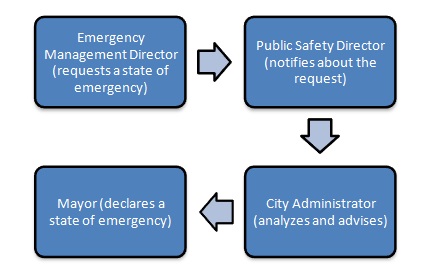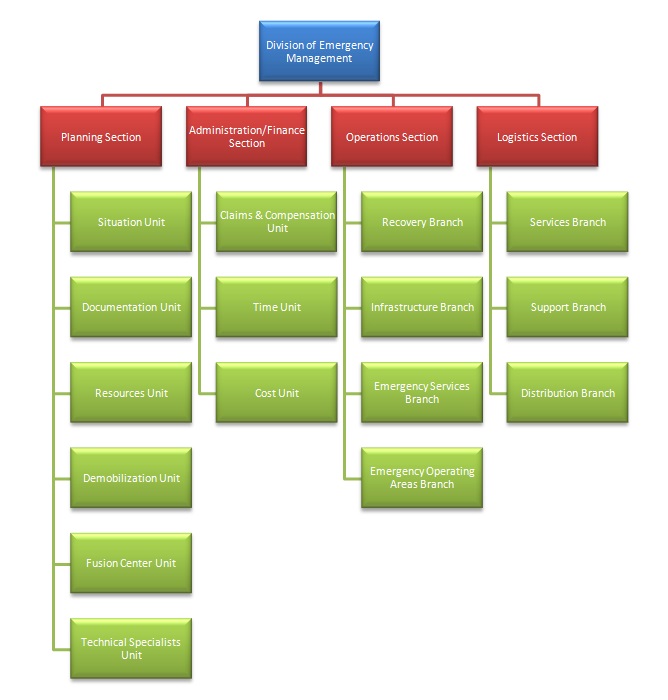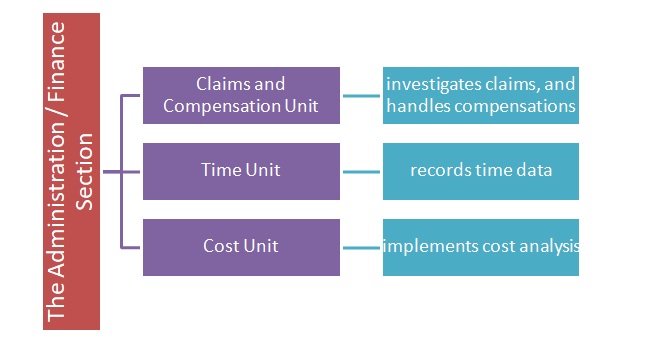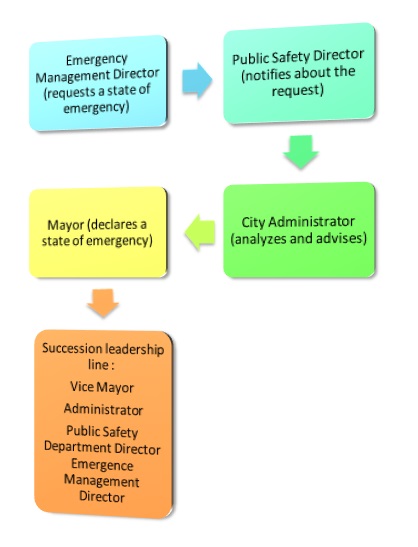Introductory Material
This Emergency Plan is developed for West Palm Beach, West Palm Beach County, Florida. In 2015, the population of the city was 106,779 people (U.S. Census Bureau, 2017). The city’s demographic data (2010 census) reveal the need to pay specific attention to such groups as the elderly, Hispanic populations, people with disabilities as the number of these people is significant, and it is steadily growing (see Figure 1).
People with special needs often require special equipment and medication as well as a particular type of care. It is noteworthy that many aging people and people with disabilities do not reside in healthcare facilities but prefer receiving care in their homes, which creates an additional load on the emergency agencies during an evacuation. Moreover, approximately 20% of residents live below poverty, which means that they do not have vehicles and tend to have limited access to communication systems used in the case of emergency (Prasad, 2016).
The number of the city’s population changes during the year. The number of farmworkers increases significantly during the harvest season, and it can be difficult to estimate the exact number of workers as some of them are illegal immigrants. A considerable part of these workers does not speak English, which should be taken into account during the implementation of communications operations (Rivera & Kapucu, 2015). The number of tourists also affects the population density during different seasons. For instance, the season lasts from January to March, and approximately 30% of tourists come during this period. During other seasons, approximately 20-25% visit the city. The city also has correctional facilities that can house over 2,500 inmates (Palm Beach County Sheriff’s Office, 2016). This is a significant number of people who should be coordinated with specific care during the evacuation, shelter-in-place, or quarantine procedures.

Promulgation Document / Signatures
This plan is to be followed in all emergency situations that can occur in West Palm Beach, Florida. The plan is updated and recognized as the county’s Emergency Operations Plan. This plan is approved and signed by the Palm Beach Board of County Commissioners. The responsible authority for the coordination, development, updating of this plan is the Division of Emergency Management (DEM) of the city.
Approval and Implementation
The DEM is the major agency responsible for the development and implementation of this emergency plan. The staff of this agency is responsible for updating this plan. The agencies that are also involved in the development and/or implementation of this plan (for instance, law enforcement or healthcare agencies) can initiate some changes. However, the DEM staff develops (in collaboration with the corresponding agencies) and adds the changes to this plan. It is applicable in case of citywide emergency or when some parts of the jurisdiction are affected. This plan supersedes all previous plans.
Record of Changes
Record of Distribution
Purpose, Scope, Situation Overview, and Assumptions
Purpose
The purpose of this Emergency Plan is to:
- Develop a comprehensive planning approach that will be utilized when addressing hazards, threats, disasters, and emergencies that may affect West Palm Beach, Florida.
- Reduce the vulnerability of all people residing in the city or visiting it.
- Describe major types of hazards, threats, disasters, and emergencies that may impact West Palm Beach, Florida.
- Describe the roles and responsibilities of the agencies involved.
Scope
This plan is to be implemented when major city-wide disasters occur.
Situation Overview
Hazard Analysis Summary
The major hazards that may affect the city include severe weather conditions that include but are not confined to hurricanes, tornadoes, droughts, and fires. Due to its geographical position, low elevation, and frequent storms, the city is vulnerable to floods. Heatwaves are also a serious hazard that mainly affects the elderly (Rivera & Kapucu, 2015). Another hazard is the risk of the spread of communicable diseases such as the Zika virus, H1N1 virus, and even Ebola. The Ebola virus was documented in Palm Beach County in 2014). Other hazards include agricultural diseases and pests, technological hazards (transportation incidents, hazardous materials, nuclear power plant accidents), and human-caused hazards (terrorism, school violence, mass migration).
Capability Assessment
The DEM collaborates with various partners as well as different agencies on the state and county levels. This collaboration ensures the ability to respond effectively to hazards. All the areas (people’s health, property safety, risks assessment, communication, and so on) are addressed due to these collaborations. The agencies provide extensive training to their employees aimed at planning, responding, and preventing various hazards. Emergency personnel also receives training (as well as formal education) from the Emergency Management Institute.
Mitigation Overview
West Palm Beach Mitigation Program involves a set of pre- and post-disaster initiatives, plans, projects, and policies aimed at reducing and preventing any damages from numerous hazards. Local Mitigation Strategy is developed in accordance with existing state and federal guidelines and is updated based on the advanced research in the sphere of emergency management. The partnerships between agencies, businesses, and individuals ensure the effective implementation of this plan.
Concept of Operations
The process of the declaration of the state of emergency includes four agents (see Figure 2). The DEM is the major coordinator of the collaboration of the agencies involved in the implementation of the emergency response. This organization notifies the agencies that are to be involved to respond to a hazard about the exact hazard that is taking place or is expected to occur. The DEM also addresses local healthcare facilities, educational establishments, and other public or private organizations to help in responding to the hazard.

Organization and Assignment of Responsibilities
The Division of Emergency Management includes a number of sections that address different areas of emergency management (see Figure 3).

The Emergency Management Director requests a local state of emergency. The Public Safety Director is notified of the need to declare the state of local emergency and addresses the City Administrator who advises the Mayor. The Mayor declares the local state of emergency.
Direction, Control, and Collaboration
When the state of emergency is declared, the city’s Emergency Operations Center (EOC) starts responding in accordance with existing plans depending on the hazard and its scale. The EOC is responsible for effective communication and coordination of agencies, organizations, and individuals involved. The EOC follows the corresponding emergency response plan, but this agency also can make decisions if some unexpected events take place.
Information Collection, Analysis, and Dissemination
The Documentation Unit of the Planning Section is responsible for data collection, analysis, and dissemination. This unit is responsible for the development of hard copies and digital copies of reports, charts, and graphics revealing the most relevant information concerning the situation. The distribution channels are mainly electronic while hard copies may be sent (especially after the completion of emergency operations).
Communications
The DEM has the responsibility to notify the agencies at state and federal levels. This organization also responses to the request of the corresponding state and federal agencies. The communication is carried out by land-line telephones, cell phones, online systems.
Administration, Finance, and Logistics
The DEM is responsible for collecting, disseminating data, developing plans and protocols as well as their dissemination. The changes to the plans are introduced by this agency through other agencies (for example, EOC, law enforcement facilities, and so on) can request the DEM to change some plans or protocols. The Administration / Finance Section involves units that focus on the needs of organizations and businesses as well as individuals associated with financial issues, recovery, and so on (see Figure 4).

The Recovery Branch includes units that focus on the coordination of resources, information, and capabilities among the involved public sector and private organizations and agencies. This branch is responsible for enhancing the stakeholders’ preparedness in pre- and post-disaster response. The lead agency is the Office of Small Business Administration, and support agencies include the DEM, Small Business Development Board, Disaster Recovery Coalition and others. The Infrastructure Branch of the DEM includes transportation unit, public works unit, and energy unit that address pre-disaster preparedness and post-disaster recovery associated with roads, transportation, and so on (Davis et al., 2014).
Plan Development and Maintenance
This plan is developed by the DEM in collaboration with other agencies. This organization provides copies of the plan to the agencies, public and private organizations involved. The Division is also responsible for the development of training to its and other agencies’ employees.
Authorities and References
Palm Beach County
- Resolution R-89-384 (Declaration of a State of Local Emergency
Florida Statutes
- Chapter 22 (Emergency Continuity of Government)
- Chapter 154 (Public Health Facilities)
- Chapter 252 (Emergency Management)
- Chapter 381 (Public Health)
- Chapter 768 (Good Samaritan Act)
Federal
- Public Law 93-288 (Federal Response Plan)
- Public Law 100-707 (The Stafford Act)
Emergency Support Function Annexes
ESF #1 – Communications
Communication systems
Communications systems available during emergencies are divided into federal, state systems, and local (Florida Disaster, 2012). A Regional Emergency Response Network is the communications system that includes radios with high capabilities enabling the systems functioning during hurricane seasons. It is also mobile, which is essential during an emergency (Rivera & Kapucu, 2015). It enables to access the most remote areas and some of the most vulnerable populations. People living in poverty have limited access to information and often learn about emergencies when it is late (Prasad, 2016). A tactical system and one station with such elements as Emergency Deployable Interoperable Communication System, a secure wireless communications network, and Tactical Satellite Communications.
The use of communications systems
The use of the systems depends on the nature of the hazard as well as the functioning of the systems as some of them may be damaged, especially in case of severe weather hazards. When all the systems operate properly, it is possible to utilize cell phones and land-line telephones as well as the Internet (to share data). However, when these lines are damaged, the Regional Emergency Response Network and Emergency Deployable Interoperable Communication System will be used.
Authority to declare states of emergency and succession
- The Mayor declares the state of local emergency.
- In the absence of Mayor, the succession leadership line includes Vice Mayor, Administrator, Public Safety Department Director, or Emergency Management Director.
The declaration process of the state of emergency

Activation of the corresponding facilities during an emergency
The Division of Emergency Management is responsible for activating and deactivating the necessary facilities. The units involved are the Documentation Unit, Resource Unit, Demobilization Unit, Administration/Finance Section, Emergency Operations Center Support Unit, the Point of Distribution Unit, Special Needs Unit.
The notification of neighboring jurisdictions
The DEM is responsible for notifying neighboring jurisdictions. The organization will use such tools as cell phones, land-line telephones, the Internet, emergency communications networks if other channels are damaged.
The coordination of communications between on-scene and off-scene staff and agencies
To manage communications between on- and off-scene personnel, it is possible to communicate via cell phones, radio, land-line telephone, or any combination of these channels (Huder, 2012).
Training and exercise
The Emergency Management Institute offers training courses concerning the use and development of communications systems. The DEM provides training to its employees. Public and private organizations are encouraged to train their employees to raise awareness of existing communications systems and the ways to use them (Rivera & Kapucu, 2015).
ESF #2 – Search and Rescue
Lead Agency
West Palm Beach Fire-Rescue
Support Agencies
- Florida Fire Chiefs Association
- Chief Fire Officers Association of Palm Beach County
- Florida Fish and Wildlife Conservation Commission
- Amateur Radio Emergency Services
- The city’s fire and police departments.
Steps were undertken to conduct an urban search, waterborne rescue, and search, aeronautical search, and rescue
The units mentioned above (in collaboration with the National Guard if necessary) locate, extricate, provide the necessary medical aid to victims trapped in collapsed buildings and structures. Waterborne search and rescue procedures involve locating (missing people and vessels or damaged aircraft of missing people), extricating, and providing medical assistance to the survivors. Aeronautical search and rescue measures involve locating, extricating, and providing medical aid to missing people in the wilderness or rural areas.
Communications and the provision of psychological support and medical aid
Department of health is the leading agency coordinating, planning, disseminating data concerning psychological support, and the provision of support and medical aid to survivors. The DEM collaborates with the Department of Health and disseminates the necessary information (protocols, guidelines, and so on) to public and private organizations and agencies.
Training and exercise
The agencies involved provide the necessary training to their employees.
Support Annexes
Population Protection
Evacuation and sheltering-in-place
A large-scale evacuation of the residents, travelers, and domesticated animals of West Palm Beach is implemented in case of such hazards as severe weather (hurricane, tornado, and so on), floods, wildfires, terrorist attacks, hazardous materials spills, and so on. It is vital to make sure that emergency personnel explains the need to leave their homes as some people are reluctant to do so. It is necessary to pay specific attention to communication with people with special needs and the elderly (Ozguven et al., 2015). The Emergency Management Director recommends initiating evacuation, and the Mayor is responsible for initiating this measure. The shelter-in-place measure is initiated when contamination occurs, the communicable disease rapidly spreads.
Emergency response for people with disabilities, aging populations, unattended minors
The aging population is one of the most vulnerable groups, and it has been estimated that over 70% of fatalities are older than 60, while almost half of the victims are over 75 (Ozguven et al., 2015). Some of the major concerns associated with emergency response for disabled people include communications and transportation (Rutkow, Taylor, & Gable, 2015). Healthcare facilities providing care to such populations have the necessary equipment to carry out transportation effectively. During emergencies, private organizations may be addressed, and their equipment can be used to implement transportation and communication successfully (Rivera & Kapucu, 2015).
Isolation and quarantine
Quarantine and isolation are initiated in case of contamination of certain territories. It is initiated by the Mayor. Law enforcement agencies (in the most serious cases, National Guard) will ensure public order ad isolation of the affected people.
Registration and document tracking actions
The Documentation Unit is responsible for registration and documentation.
Management and relocation of incarcerated individuals
Correctional facilities have the corresponding emergency plans and protocols disseminated by the DEM. These facilities ensure the effective implementation of evacuation, shelter-in-place, quarantine, or isolation of incarcerated people. If some damage is caused to the necessary equipment and vehicles, the facilities address the Emergency Operations Center that provides the necessary tools.
Actions are undertaken to respond to people’s refusal to leave their houses

Management and coordination of pets’ evacuation
The DEM includes the Animal Services Unit that collaborates with the Division of Animal Care and Control, American Red Cross, Florida Fish, and Wildlife Conservation Commission to ensure the effective evacuation of pets.
Training and exercise
The organizations involved provide training to their employees. The DEM, as well as the organizations and agencies mentioned in this section, may initiate some exercise to train their employees.
Hazard-, Threat-, or Incident-Specific Annexes
Flood
Hazard summary
Flood is a rise in water, which is often a result of heavy rains or failure of water control structures such as dams (National Weather Service, n.d.). Floods often cause significant damage to infrastructure as roads and railways are often affected. In severe conditions, buildings can also be substantially damaged. It is often associated with a threat of contamination of food and drinking water, and the spread of diseases in people and animals.
Authority and agencies to notify, mitigate against, prepare, and respond to, as well as recover from the disaster

Resources
The agencies mentioned above provide the necessary resources. The DEM and Emergency Operations Center can also address private and public organizations that can provide assistance and resources.
Transportation
Since infrastructure may be damaged, air transportation can be used to implement search and rescue operations.
Public safety
Public safety can be ensured by local law enforcement agencies and the National Guard if necessary.
Training and exercise
The DEM, as well as the organizations and agencies mentioned in this section, can initiate some exercise to train their employees.
Biological Incident
Hazard summary
- Zika virus is one of the most serious hazards that may occur in West Palm Beach. The virus is associated with such birth defects as microcephaly when contracted by pregnant females (Florida Health, 2017). Children affected by microcephaly tend to have smaller brains and have developmental disorders.
- The spread of H1N1 in the county in 2009-2010 put under threat the health of thousands of people. This disease is still regarded as one of the most serious biological threats that are addressed via vaccination, shelter-in-place, and quarantine measures.
- A suspected case of Ebola in the county also reveals the need to develop a sound plan of treating passengers coming from different areas affected by epidemics (Rivera & Kapucu, 2015).
Agencies involved
The involved agencies are the Division of Emergency Management, the Mayor who declares the state of emergency, the Department of Health, Florida Department of Environmental Protection (assists in investigating and determining various disease outbreaks), the Center for Disease Control and Prevention city’s healthcare facilities.
Assessment, prevention and protection measures
Department of Health and the Center for Disease Control and Prevention assess and monitor the number of affected people. Department of Health coordinates the population’s vaccination.
Communications
The major communication channels may include cell phones, land-line telephone, online channels, or any combination of these methods. If the biological hazard is accompanied by severe weather conditions and some channels are damaged, it is necessary to use emergency networks (for example, Emergency Deployable Interoperable Communication System).
Isolation and quarantine
Isolation and quarantine procedures should be implemented as there is a threat to the development of an epidemic. Individuals are isolated in healthcare facilities, and there can be no need in addressing law enforcement agencies. The local law enforcement agencies (National Guard, if necessary) ensure the effective implementation of large-scale isolation and quarantine measures.
Transportation
The continuity of transportation should be monitored as the high rate of absenteeism may significantly impair the process. The coordination of travel from and to the affected territories is essential to reduce the threat of the spread of a possible epidemic.
Public safety
Local law enforcement agencies will ensure the implementation of the quarantine measures as well as maintenance of public order as epidemics can be associated with an increased level of criminal activity and public unrest.
Training and exercise
Department of Health in collaboration with the DEM and local healthcare facilities provides training and exercise to their employees.
References
Davis, J., Paramygin, V., Vogiatzis, C., Sheng, Y., Pardalos, P., & Figueiredo, R. (2014). Strengthening the resiliency of a coastal transportation system through integrated simulation of storm surge, inundation, and nonrecurrent congestion in Northeast Florida. Journal of Marine Science and Engineering, 2(2), 287-305.
Florida Disaster. (2012). The State of Florida comprehensive emergency management plan. Web.
Florida Health. (2017). Zika virus. Web.
Huder, R. (2012). Disaster operations and decision making. Hoboken, NJ: John Wiley & Sons.
National Weather Service. (n.d.). Flood safety. Web.
Ozguven, E., Horner, M., Kocatepe, A., Marcelin, J., Abdelrazig, Y., Sando, T., & Moses, R. (2015). Metadata-based needs assessment for emergency transportation operations with a focus on an aging population: A case study in Florida. Transport Reviews, 36(3), 383-412.
Palm Beach County Sheriff’s Office. (2016). Corrections general.
Prasad, S. (2016). Assessing the need for evacuation assistance in the 100 year floodplain of South Florida. Applied Geography, 67, 67-76.
Rivera, F., & Kapucu, N. (2015). Disaster vulnerability, hazards and resilience. Orlando, FL: Springer.
Rutkow, L., Taylor, H., & Gable, L. (2015). Emergency preparedness and response for disabled individuals: Implications of recent litigation. The Journal of Law, Medicine & Ethics, 43(s1), 91-94.
U.S. Census Bureau. (2017). People.